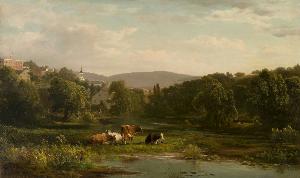De Witt Clinton Boutelle
De Witt Clinton Boutelle
Place: Manchester
Born: 1822
Death: 1884
Biography:
De Witt Clinton Boutelle was an American artist born in Manchester, Vermont in 1822. He was a member of the Hudson River School, a mid-19th-century American art movement characterized by romanticism and a focus on landscape painting. Boutelle's work often depicted the Hudson River Valley and the surrounding area, including the Catskill Mountains, Adirondack Mountains, and White Mountains of New Hampshire.
Artistic Career
Boutelle's artistic style was influenced by the Hudson River School movement, which emphasized the beauty of the natural world. His paintings often featured serene landscapes with rolling hills, majestic mountains, and tranquil waterways. Boutelle's use of light and color created a sense of depth and atmosphere in his paintings, drawing the viewer into the scene. Some notable artists associated with the Hudson River School include Thomas Cole, Asher Brown Durand, and Frederic Edwin Church. These artists were known for their prolific output and their mastery of landscape painting. Boutelle's work can be seen in the context of this movement, with his paintings reflecting the same themes and styles.
Notable Works
Boutelle's paintings are characterized by their attention to detail and their emphasis on the natural world. Some notable works by the artist include:
- A Stream in the Rocky Mountains, a painting that showcases Boutelle's ability to capture the beauty of the natural world.
- Genesee Scenery, a landscape painting that features the Genesee River and the surrounding mountains.
- The Last Valley - Paradise Rocks, a painting that demonstrates Boutelle's use of light and color to create a sense of depth and atmosphere.
These paintings can be seen at various museums, including the Rhode Island School of Design Museum of Art and the USC Fisher Museum of Art. For more information on De Witt Clinton Boutelle and his work, visit De Witt Clinton Boutelle's page on Wikioo.org.
Legacy
Boutelle's legacy as an artist is characterized by his contributions to the Hudson River School movement. His paintings continue to be celebrated for their beauty and their ability to capture the natural world. For more information on the Hudson River School, visit the Hudson River School page on Wikipedia. De Witt Clinton Boutelle's work can be seen as an example of the romanticism and naturalism that characterized the Hudson River School movement. His paintings continue to inspire artists and art lovers today, and his legacy as a member of the Hudson River School remains an important part of American art history.


